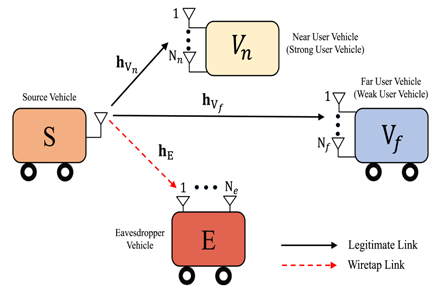|
Full title—Physical Layer Security Performance of NOMA-Aided Vehicular Communications over Nakagami-m Time-Selective Fading Channels with Channel Estimation Errors
This paper considers a single-input-multiple-output non-orthogonal multiple access enabled vehicular communication system, and investigates its secrecy performance over time-selective fading and channel estimation errors.

System model for secure SIMO NOMA-aided V2V communications
We formulate two scenarios considering the decoding ability at eavesdropper:
Scenario I: when it has sufficient decoding capability, and
Scenario II: when its decoding capability can be the same as the legitimate vehicles
Under such a realistic system setup, we derive the secrecy outage probability (SOP) and ergodic secrecy capacity expressions for both legitimate vehicles and the overall system under both Scenarios I & II over Nakagami-m fading channels.
We then analyze the asymptotic SOP limits of both legitimate vehicles under Scenarios I & II, by formulating cases based on the average transmit signal-to-noise ratio and average channel gains associated with the main links and wiretap link.
From the asymptotic analysis under these cases, it is observed that both legitimate vehicles do not achieve any secrecy diversity order even after leveraging the benefits of fading severity parameters and multiple antennas. We also formulate several special cases of interest to reveal some more insightful information about the system's secrecy performance.
Finally, we corroborate our analytical and theoretical findings via simulation results.
Full Article: IEEE Open Journal of Vehicular Technology, Early Access, 2022

|